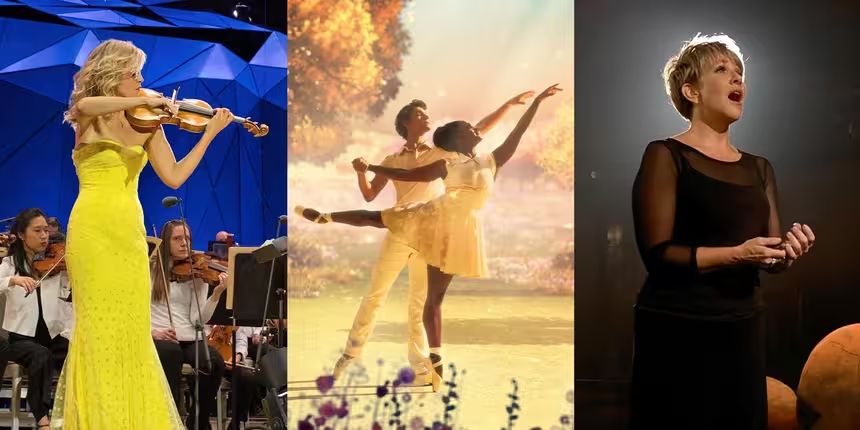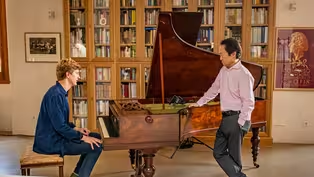
First 10 Minutes of Now Hear This "Chopin"
Clip: Season 52 Episode 9 | 9m 28sVideo has Closed Captions
Enjoy this sneak preview of Now Hear This "Chopin."
Explore the life and works of famed polish composer Frédéric Chopin in this clip from the first episode of Now Hear This Season 6, Now Hear This "Chopin's Polish Heart."
Problems playing video? | Closed Captioning Feedback
Problems playing video? | Closed Captioning Feedback
Major series funding for GREAT PERFORMANCES is provided by The Joseph & Robert Cornell Memorial Foundation, the Anna-Maria and Stephen Kellen Arts Fund, the LuEsther T. Mertz Charitable Trust, Sue...

First 10 Minutes of Now Hear This "Chopin"
Clip: Season 52 Episode 9 | 9m 28sVideo has Closed Captions
Explore the life and works of famed polish composer Frédéric Chopin in this clip from the first episode of Now Hear This Season 6, Now Hear This "Chopin's Polish Heart."
Problems playing video? | Closed Captioning Feedback
How to Watch Great Performances
Great Performances is available to stream on pbs.org and the free PBS App, available on iPhone, Apple TV, Android TV, Android smartphones, Amazon Fire TV, Amazon Fire Tablet, Roku, Samsung Smart TV, and Vizio.
Buy Now

Great Performances Newsletter
Subscribe to the Great Performances newsletter to keep up with the latest full episodes to stream, exclusive content, and more!Providing Support for PBS.org
Learn Moreabout PBS online sponsorship♪♪ In the Hôtel des Invalides, Napoleon's veterans hospital, is the Museum of Relief Maps.
It houses military models from a time when Europe was almost constantly at war.
I met with their director, Isabelle Warmoes.
This model is showing the art of siege warfare used a little before the period of Chopin, and you can see the encampment of the army near the city they want to attack.
There seems to be a wall there.
Yes.
To protect the campmen from the cannonball of the sea.
See?
They had to build this fortification of earth.
So are they working at night?
Yes, Because during the night, nobody can see you and they can put cannons to bombard the city.
Interesting.
Now to go inside the fortification.
They're making a channel.
That's very, very bold.
And you can see that cannonballs star to destroyed the fortification.
To permit the soldiers to go inside.
And the city will be down in a few moments.
With foreign powers occupying Poland, a young Frédéric Chopin fled for Paris.
So this kind of military models were made to understand the fortification and the landscape and with this kind of models, the King could see all the cities without moving to the border.
But to see the vulnerabilities of the city or something?
Exactly.
- Interesting.
All the buildings are made of wood and pape or the trees are made of silk.
It's cartography, but pieces of art, too.
It's both.
- Its both, really.
♪♪ Like these models, Chopin built musical worlds in miniature.
Because he wrote mostly for piano, I don't know him well.
So I've been reading his letters.
He said “I can express my feelings more easily if they're put into notes of music.” But his writing shows a gift for language and reveals an art shaped by his homeland, close friendships in Paris, and a quest for the purest music.
♪♪ To help me understand Chopin, I called Polish Canadian pianist Jan Lisiecki.
♪♪ It's so nice that they keep this so beautiful for everybody to enjoy.
Absolutely.
Chopin was born in the Polish countryside outside Warsaw.
I start there with Jan and Polish cellist Maria Leszczyska.
It's pretty opulent place for the Chopins to live.
Well, not quite.
Chopin's father moved here as a teacher to the aristocratic family that lived on the grounds and met his mother, who was a down on her luck aristocrat.
And they married.
They lived here in a servants house.
And in fact, this is the very house in which Chopin was born.
We're able to visit it now.
- Wow.
You know, even as servant's quarters, this is really beautiful.
It's kind of lavish.
In Chopin's time, it probably would have looked quite different.
More like a barn, possibly even with a dirt floor.
It was not nearly as beautiful as it is today.
But in any case, I don't think that matters very much since he didn't stay here very long.
Yeah, they were here only for a few months.
They moved to Warsaw, actually, because his father started teaching at the private high school.
And Chopin was also educated there, so he was pretty well educated.
So in Warsaw, he was surrounded by this high society, by the nobility, by culture, by art.
And he would still continue to come here as a family for holidays.
So, in elazowa Wola, like he had the rural Polish experience, I think that really shaped who he became.
The nobility of Warsaw, the culture of Warsaw, and the Polish culture of elazowa Wola.
Can we go inside?
Without a doubt.
- Okay.
Now, I've never played this piece before.
Neither have I.
It's not played so much but I think, as one can imagine, Chopin was quite a child prodigy.
He started composing when he was six.
He continued writing through his youth, his teens, and into his adult life.
This piece somehow still has some of that youthful energy.
And I believe he wrote it for an exam, didn't he?
Yeah, I think so.
During his studies.
Yeah.
He was really young at this time.
Wonder what mark he got for this.
I bet an A I would give him an A.
Let's try it.
♪♪ If this sounds like a Beethoven trio, he was one of Chopin's early influences.
Though Chopin would soon find his own path.
In one letter, he wrote, “Beethoven challenges the Universe.
I decided my universe woul be the soul and heart of man.” ♪♪ Chopin landed in Paris at 20 years old and was embraced by other artists of the French romantic movement, like the painter Théodore Géricault, famous for his horses Jan and I went to see them at the Museum of Romantic Life with French cellist Camille Tomas.
Yeah.
This one is really special.
- Yeah.
Just the light.
- Yes.
And it's such a simple subject.
And it can be so poetic.
Can have so much meaning.
Little bit like Chopin's music.
I think it has this simplicity, but complexity and leaves space for your own emotions.
Emotion and expression, for sure.
It's almost human.
It's beautiful.
- And listening.
Aware, no?
He's open.
Géricault was a good example of French romanticism.
And Géricault horses, studied them in Versailles, spent a lot of time making sure that his depictions were true to how they looked.
And actually did a lot of miniatures, just like Chopin.
And it's actually likely that he and Chopin met in this very, very room we are standing.
And Chopin would have been playing some miniatures of his own.
Géricault might have exhibited some of these paintings.
Also, like Chopin, he led a similar life.
He started very early, had his first major success at the age of 21, a true masterpiece, but died young.
Oh, what a beautiful room.
Stunning.
So before becoming the Museum of Romantic Life, this was Ary Scheffer's house.
And he lived here for about 20 years and hosted in these very rooms salons, which guested the likes of Chopin or George Sand.
What makes it quite interesting is Chopin was different than the rest of them.
While we may think Chopin's music is Romantic because of the emotions we feel when we hear it, actually in definition, it is not Romantic.
Romantic artists would focus on creating art that was linked with nature.
With a storm or the sea or some certain ideal.
But Chopin like to keep his music pure.
He likes to write beauty for the sake of beauty.
It's almost like he went in the opposite direction from the Romantics, like it's almost the negative image of a Romantic composer.
He wrote little pieces, shorter pieces for one instrument, versus the Romantics which were trying to push the boundaries.
Larger orchestras, longer symphonies.
But Chopin came from Poland with his own ideas, his own way of writing.
And despite being surrounded and embraced by these Romanticists, he stuck to his own voice.
Now Hear This “Chopin’s Polish Heart” Preview
Video has Closed Captions
Preview: S52 Ep9 | 30s | Explore Chopin’s musical evolution from Poland to Paris with Scott Yoo and pianist Jan Lisiecki. (30s)
Now Hear this Season 6 Preview
Video has Closed Captions
Preview: S52 Ep9 | 30s | Journey to Poland, Spain and more in this season of Now Hear This. (30s)
Providing Support for PBS.org
Learn Moreabout PBS online sponsorshipSupport for PBS provided by:
Major series funding for GREAT PERFORMANCES is provided by The Joseph & Robert Cornell Memorial Foundation, the Anna-Maria and Stephen Kellen Arts Fund, the LuEsther T. Mertz Charitable Trust, Sue...

















